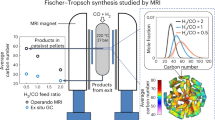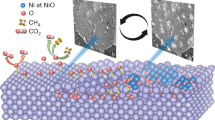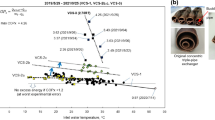Abstract
More than 85 per cent of all chemical industry products are made using catalysts1,2, the overwhelming majority of which are heterogeneous catalysts2 that function at the gas–solid interface3. Consequently, much effort is invested in optimizing the design of catalytic reactors, usually by modelling4 the coupling between heat transfer, fluid dynamics and surface reaction kinetics. The complexity involved requires a calibration of model approximations against experimental observations5,6, with temperature maps being particularly valuable because temperature control is often essential for optimal operation and because temperature gradients contain information about the energetics of a reaction. However, it is challenging to probe the behaviour of a gas inside a reactor without disturbing its flow, particularly when trying also to map the physical parameters and gradients that dictate heat and mass flow and catalytic efficiency1,2,3,4,5,6,7,8,9. Although optical techniques10,11,12 and sensors13,14 have been used for that purpose, the former perform poorly in opaque media and the latter perturb the flow. NMR thermometry can measure temperature non-invasively, but traditional approaches applied to gases produce signals that depend only weakly on temperature15,16 are rapidly attenuated by diffusion16,17 or require contrast agents18 that may interfere with reactions. Here we present a new NMR thermometry technique that circumvents these problems by exploiting the inverse relationship between NMR linewidths and temperature caused by motional averaging in a weak magnetic field gradient. We demonstrate the concept by non-invasively mapping gas temperatures during the hydrogenation of propylene in reactors packed with metal nanoparticles and metal–organic framework catalysts, with measurement errors of less than four per cent of the absolute temperature. These results establish our technique as a non-invasive tool for locating hot and cold spots in catalyst-packed gas–solid reactors, with unprecedented capabilities for testing the approximations used in reactor modelling.
This is a preview of subscription content, access via your institution
Access options
Subscribe to this journal
Receive 51 print issues and online access
$199.00 per year
only $3.90 per issue
Buy this article
- Purchase on Springer Link
- Instant access to full article PDF
Prices may be subject to local taxes which are calculated during checkout




Similar content being viewed by others
References
Hagen, J. Industrial Catalysis: A Practical Approach 2 (2nd edn, Wiley-VCH, 2006)
Chorkendorff, I. & Niemantsverdriet, J. W. Concepts of Modern Catalysis and Kinetics 11 (2nd edn, Wiley-VCH, 2007)
Rothenberg, G. Catalysis: Concepts and Green Applications 129 (1st edn, Wiley-VCH, 2008)
Schwiedernoch, R., Tischer, S., Deutschmann, O. & Warnatz, J. Experimental and numerical investigation of the ignition of methane combustion in a platinum-coated honeycomb monolith. Proc. Combust. Inst. 29, 1005–1011 (2002)
Buurmans, I. L. C. et al. Catalytic activity in individual cracking catalyst particles imaged throughout different life stages by selective staining. Nature Chem. 3, 862–867 (2011)
de Smit, E. et al. Nanoscale chemical imaging of a working catalyst by scanning transmission X-ray microscopy. Nature 456, 222–225 (2008)
Gladden, L. F. Applications of in situ magnetic resonance techniques in chemical reaction engineering. Top. Catal. 8, 87–95 (1999)
Lysova, A. A. & Koptyug, I. V. Magnetic resonance imaging methods for in situ studies in heterogeneous catalysis. Chem. Soc. Rev. 39, 4585–4601 (2010)
Horn, R. et al. Reactor for in-situ measurements of spatially resolved kinetic data in heterogeneous catalysis. Rev. Sci. Instrum. 81, 064102 (2010)
Taylor, S. J. & Morken, J. P. Thermographic selection of effective catalysts from an encoded polymer-boundary library. Science 280, 267–270 (1998)
Urakawa, A. & Baiker, A. Space-resolved profiling relevant in heterogeneous catalysis. Top. Catal. 52, 1312–1322 (2009)
Korup, O., Mavlyankariev, S., Geske, M., Goldsmith, C. F. & Horn, R. Measurement and analysis of spatial reactor profiles in high temperature catalysis research. Chem. Eng. Process. 50, 998–1009 (2011)
Dietrich, T. R. Microchemical Engineering in Practice 199–239 (Top. Appl. Phys. 10, Wiley, 2009)
Jensen, K. F. et al. in Microreaction Technology (ed. Ehrfeld, W. ) 2–9 (Springer, 1997)
Beckmann, P. A. & Dybowski, C. A thermometer for non-spinning solid state NMR spectroscopy. J. Magn. Reson. 146, 379–380 (2000)
Callaghan, P. T. Principles of Nuclear Magnetic Resonance Microscopy 59–69 328–419 (Oxford Univ. Press, 1994)
Galiana, G., Branca, R. T., Jenista, E. R. & Warren, W. S. Accurate temperature imaging based on intermolecular coherences in magnetic resonance. Science 322, 421–424 (2008)
Webb, A. G. Temperature measurements using NMR. Ann. Rep. NMR Spectrosc. 45, 1–67 (2002)
Cussler, E. L. Diffusion: Mass Transfer in Fluid Systems 13–45 (Cambridge Univ. Press, 1997)
Ferstl, W. et al. Inline analysis in microreaction technology: a suitable tool for process screening and optimization. Chem. Eng. Technol. 30, 370–378 (2007)
Bouchard, L. S. et al. NMR imaging of catalytic hydrogenation in microreactors with the use of parahydrogen. Science 319, 442–445 (2008)
Adams, R. W. et al. Reversible interactions with para-hydrogen enhance NMR sensitivity by polarization transfer. Science 323, 1708–1711 (2009)
Bowers, C. R. & Weitekamp, D. P. Parahydrogen and synthesis allow dramatically enhanced nuclear alignment. J. Am. Chem. Soc. 109, 5541–5542 (1987)
Eisenschmid, J. et al. Para hydrogen induced polarization in hydrogenation reactions. J. Am. Chem. Soc. 109, 8089–8091 (1987)
Duckett, S. B. & Wood, N. J. Parahydrogen-based NMR methods as a mechanistic probe in inorganic chemistry. Coord. Chem. Rev. 252, 2278–2291 (2008)
Kovtunov, K. V., Beck, I. E., Bukhtiyarov, V. I. & Koptyug, I. V. Observation of parahydrogen-induced polarization in heterogeneous hydrogenation on supported metal catalysts. Angew. Chem. Int. Ed. 47, 1492–1495 (2008)
Sharma, R. & Bouchard, L. S. Strongly hyperpolarized gas from parahydrogen by rational design of ligand-capped nanoparticles. Sci. Rep. 2, 277–281 (2012)
Deng, H. et al. Multiple functional groups of varying ratios in metal-organic frameworks. Science 327, 846–850 (2010)
Doonan, C. J., Morris, W., Furukawa, H. & Yaghi, O. M. Isoreticular metalation of metal-organic frameworks. J. Am. Chem. Soc. 131, 9492–9493 (2009)
Burt, S. R. MRI of Heterogeneous Hydrogenation Reactions Using Parahydrogen Polarization 37–39, 69–100. PhD thesis, Univ. California, Berkeley. (2008)
Acknowledgements
We thank J. Reimer, C. T. Campbell, W. S. Warren, I. Oppenheim and R. Bruinsma for discussions; N. K. Garg, C. T. Campbell, W. Gelbart and C. Knobler for reading the manuscript; M. T. Yeung for technical help with MATLAB; and J. Brown and R. Sharma for assistance with chemical synthesis. This work was funded by a Dreyfus New Faculty Award (L.-S.B.); a Beckman Young Investigator Award (L.-S.B.); US NSF CHE-1153159 (L.-S.B., O.M.Y.); BASF, Germany (synthesis); and the US DOE (O.M.Y.; porosity measurements).
Author information
Authors and Affiliations
Contributions
N.N.J., S.G., T.O., A.M. and S.R.B. performed the experiments and collected the data. N.N.J. and W.M. performed the chemical synthesis. N.N.J., S.G., T.O., A.M., S.R.B. and L.-S.B. conducted the data processing and error analysis. N.N.J., S.G., S.R.B., O.M.Y. and L.-S.B. wrote the paper. All authors discussed the results and commented on the manuscript.
Corresponding author
Ethics declarations
Competing interests
The authors declare no competing financial interests.
Supplementary information
Supplementary Information
This file contains Supplementary Methods, Supplementary Figures 1-15, Supplementary Text and Data, Supplementary Tables 1-4 and additional references. (PDF 2037 kb)
Rights and permissions
About this article
Cite this article
Jarenwattananon, N., Glöggler, S., Otto, T. et al. Thermal maps of gases in heterogeneous reactions. Nature 502, 537–540 (2013). https://doi.org/10.1038/nature12568
Received:
Accepted:
Published:
Issue Date:
DOI: https://doi.org/10.1038/nature12568
This article is cited by
-
Operando magnetic resonance imaging of product distributions within the pores of catalyst pellets during Fischer–Tropsch synthesis
Nature Catalysis (2023)
-
An In-Situ MRI Method for Quantifying Temperature Changes during Crystal Hydrate Growths in Porous Medium
Journal of Thermal Science (2022)
-
Experimental implementation of an NMR NOON state thermometer
Quantum Information Processing (2019)
-
Synthesis and Properties of Al2O3@Al Metal–Ceramic Core–Shell Microstructures for Catalyst Applications
Topics in Catalysis (2015)
Comments
By submitting a comment you agree to abide by our Terms and Community Guidelines. If you find something abusive or that does not comply with our terms or guidelines please flag it as inappropriate.



